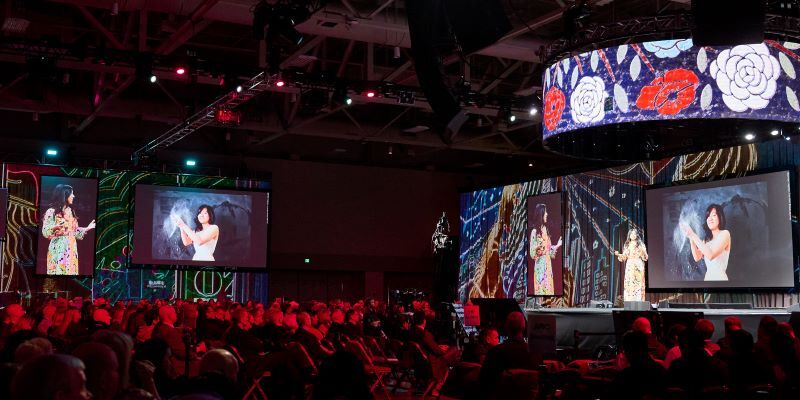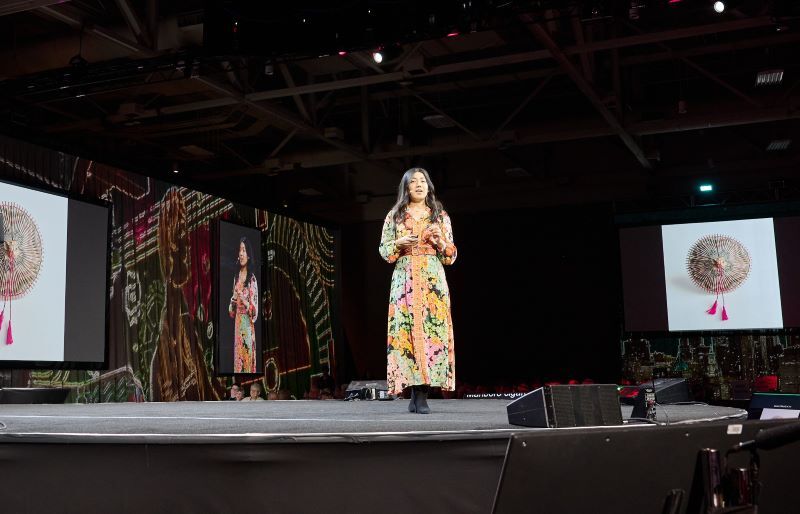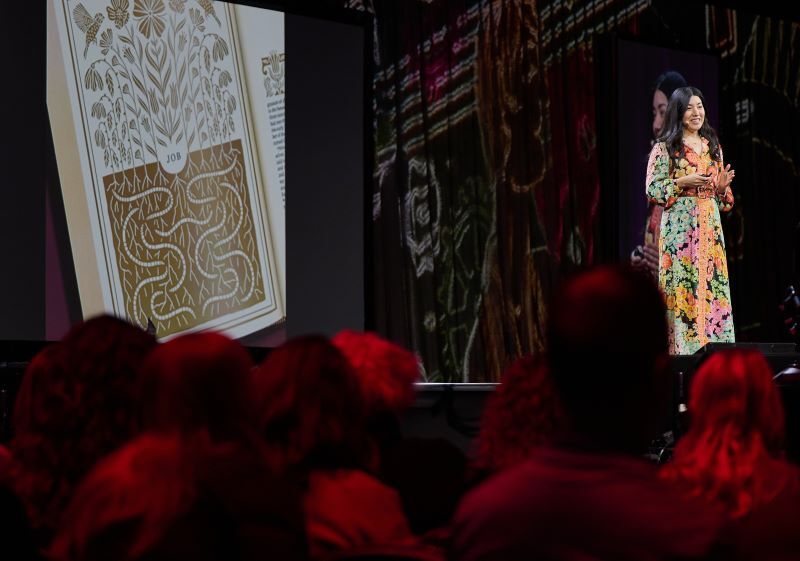“Art, much like genealogy, is about weaving stories from the past into something meaningful for us in the present and the future.”
This was the perfect way for Dana Tanamachi to kick off her keynote address at RootsTech 2025. As an artist with Japanese- and Mexican-American heritage, Dana shared that she always felt like she was living between two worlds: “one rooted in precision, minimalism, and restraint, and the other in vibrancy, passion, and bold expression.” Although these cultures might be seemingly opposite, Dana's unique perspective has resulted in meaningful and beautiful artistic creations.
Who Is Dana Tanamachi?
Dana Tanamachi has been an independent artist for almost 15 years now and absolutely loves what she does. Much of her work has centered on design, creating custom work for many well-known brands and organizations.
Some of her projects include food packaging, gold foil stamps for the United States Postal Service, and large-scale murals for nonprofit organizations and global corporations. She has also designed reusable shopping bags for the gift company Blue Q, posters for the Library of Congress’s National Book Festival, and even vintage-inspired book covers for Puffin Books.
As her beautiful book cover designs were displayed on screens around her onstage, Dana said, “I love combining typography and illustration to create images that feel nostalgic and familiar, yet fun and modern.”

Dana’s Artistic Journey
How did Dana get started? She would say that she had “two very separate careers.” Previously, she was most known for her work in a particular medium—chalk, specifically, chalkboard paint. In 2009, what Dana thought was just a casual doodle on a chalkboard at a friend’s party turned into the start of something much bigger.
Throughout the year following her doodle, more friends wanted her to create chalkboard designs to use as backdrops or photo walls at their own parties. After one of her friends posted Dana’s work on Facebook, Dana began to receive her first commissions. She created chalkboard designs for friends’ parties, businesses, weddings, and hotels. Bigger things also came her way when she was commissioned by Oprah, TIME magazine, Michelle Obama, Burton Snowboards, and Penguin Books.
“I somehow found myself the unlikely author of a worldwide design trend at the age of 26,” Dana said. However, she didn’t want to confine her craft to a single medium. So, she later decided to step back from the chalk and continue to evolve as an artist.
A Rich Heritage of Art and Perseverance
Dana’s family story can be summarized in one word: gaman (我慢), which is a Japanese term meaning “to endure the seemingly unbearable with patience and dignity.”
While talking about the trials and impact of her family’s history, Dana said, “My family’s firsthand pilgrimage through a literal and figurative desert has taught me so much about the power of beauty and creativity, especially in the midst of dire circumstances and seemingly hopeless situations.”
In 1942, after the bombing of Pearl Harbor, Dana’s grandmother and grandfather—who were teenagers at the time—were put in Japanese internment camps in the Arizona desert, along with their families and approximately 18,000 others. Family members could take only what they could carry, and the days were bleak and seemed like an eternity. “For three long years, they endured harsh conditions, the loss of their rights and freedom, and the deep injustice of being treated as enemies in their own beloved homeland.”
Despite these conditions, the internees built “a sense of community and order amidst the chaos.” They were able to sort themselves into departments, such as teachers, doctors and nurses, cooks, and farmers. The internees also built their own makeshift libraries, churches, and baseball teams.

Dana’s grandmother Mitsy worked in the sewing department making patterns, while her grandfather Tom was put in the drafting department, because he had been studying architecture back home. Tom and Mitsy later met at a social event in camp, and Mitsy thought “Tom was the most handsome man she had ever seen.” They got married soon after meeting.
While in camp, Mitsy’s mother (Dana’s great-grandmother) made several elaborate and exquisite crafts that have been passed through her family. Dana’s favorite was a small origami umbrella, about 6 inches in diameter, made from toothpicks, half of a lacquered chopstick, and cigarette wrappers. This miniature creation was a great example of the internees working with what they had to make something beautiful, and how they found art in the most unlikely of places.
Illustrating the Bible
One of Dana’s biggest projects to date has been creating the English Standard Version (ESV) Illuminated Bible: “The concept . . . was a modern take on a traditional illuminated Bible—a reverent reinterpretation of beautifully and elegantly drawn typography, ornamentation, and illustrations found in illuminated texts of old.” Historically, this kind of Bible was available only to the wealthy, so Dana was very interested in making a beautiful book equally available and accessible to all.
In sharing the scope of the project, Dana said, “This included 64 full-page book-opener illustrations full of symbol and metaphor, 50 full-page verse illustrations which were mostly typographic in nature, 250-plus hand-lettered margin verses spread over the 66 books, and over a hundred other pieces of extra ornamentation throughout.”
While this was already a massive undertaking, Dana also found the project to be difficult as it occurred during a period of depression in her life. However, she acknowledged, “The beauty that adorns these pages was born of some of the deepest pain I have experienced.”
To Dana, the most meaningful piece of art that she created in this version of the Bible was for the Book of Job. “One day, through the tears, I put pen to paper, and the artwork came flowing out of me with the kind of ease that I find hard to even describe.” The story of Job resonated with Dana as Job endured and suffered through countless trials in his life and family, and she saw herself in the pages of his book.

The illustration is split in half horizontally along the page. On the bottom is a maze of intricate roots weaving through the darker coloring of the ground, while the top is filled with flowers springing up from the dirt, although some flowers are more wilted than others.
Uniquely, the roots in the dirt rather than the flowers are the focus of the art. Dana explained, “We always want to focus on the pretty part, the flowers blooming and the sun shining, but it’s this damp, dark environment where seedlings crack open and allow the blossom to breach the surface.”
In the middle of the wilted flowers is one flower upright and whole, which “represents Job’s refusal to blame or curse the heavens and to cling to hope, even while his body—symbolized by the outer flowers—wastes away.” Dana saw Job’s story as a powerful example of “enduring the seemingly unbearable parts of the human experience with patience and dignity.”
Through her work, Dana has learned that she has done and can do hard things in her life. “When I hold [the ESV Illuminated Bible] in my hand, it’s a symbol of perseverance and endurance, that my struggle was not in vain. My greatest pain produced the thing I’m perhaps the most proud of.”
Dana closed her message by reflecting on the legacy her ancestors have given her. Using simple materials to create beautiful things is in her blood. Her ancestors left an impact, inspiring and empowering Dana generations later to create unique things and find beauty in unlikely places. “We cannot underestimate the power of creativity in trying times, using it as an act of hope when life feels beyond our control.”
What Is RootsTech?
RootsTech is a place to learn, be inspired, and make connections through family history. Hosted by FamilySearch and sponsored by other leading genealogy organizations, RootsTech has hundreds of expert classes, tips and tricks videos, and inspiring stories that can help you experience family history like never before. Visit our on-demand learning library, or make plans to join us for our next virtual or in-person conference event.
Related Articles
At FamilySearch, we care about connecting you with your family, and we provide fun discovery experiences and family history services for free. Why? Because we cherish families and believe that connecting generations can improve our lives now and forever. We are a nonprofit organization sponsored by The Church of Jesus Christ of Latter-day Saints. To learn more about our beliefs, click here.






